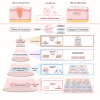Exosomes: compositions, biogenesis, and mechanisms in diabetic wound healing
- PMID: 38970103
- PMCID: PMC11225131
- DOI: 10.1186/s12951-024-02684-1
Exosomes: compositions, biogenesis, and mechanisms in diabetic wound healing
Abstract
Diabetic wounds are characterized by incomplete healing and delayed healing, resulting in a considerable global health care burden. Exosomes are lipid bilayer structures secreted by nearly all cells and express characteristic conserved proteins and parent cell-associated proteins. Exosomes harbor a diverse range of biologically active macromolecules and small molecules that can act as messengers between different cells, triggering functional changes in recipient cells and thus endowing the ability to cure various diseases, including diabetic wounds. Exosomes accelerate diabetic wound healing by regulating cellular function, inhibiting oxidative stress damage, suppressing the inflammatory response, promoting vascular regeneration, accelerating epithelial regeneration, facilitating collagen remodeling, and reducing scarring. Exosomes from different tissues or cells potentially possess functions of varying levels and can promote wound healing. For example, mesenchymal stem cell-derived exosomes (MSC-exos) have favorable potential in the field of healing due to their superior stability, permeability, biocompatibility, and immunomodulatory properties. Exosomes, which are derived from skin cellular components, can modulate inflammation and promote the regeneration of key skin cells, which in turn promotes skin healing. Therefore, this review mainly emphasizes the roles and mechanisms of exosomes from different sources, represented by MSCs and skin sources, in improving diabetic wound healing. A deeper understanding of therapeutic exosomes will yield promising candidates and perspectives for diabetic wound healing management.
Keywords: Diabetes; Exosomes; Immune regulation; MSCs; Regeneration; ncRNAs.
© 2024. The Author(s).
Conflict of interest statement
The authors declare no competing interests.
The authors declare that there is no conflict of interest regarding the publication of this paper.
Figures




References
Publication types
MeSH terms
Grants and funding
LinkOut - more resources
Full Text Sources

